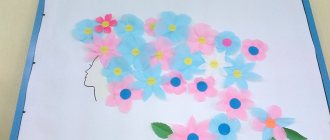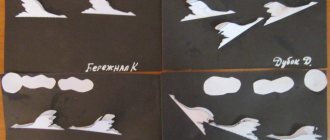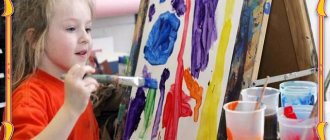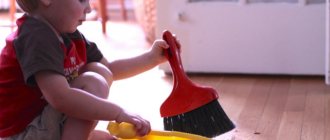Organization of manual labor in kindergarten
On the organization of
manual labor in kindergarten
“The world will be happy only when every person has the soul of an artist. In other words, when everyone finds joy in their work,” Rodin
.
Artistic work
- this is a productive and at the same time instrumental activity in which the child masters tools (scissors, knife, stapler, needle, crochet hook, etc.), explores the properties of various materials (paper, fabric, dough, foil, leaves, etc. ) and transforms them in cultural ways in order to obtain a specific result.
Artistic manual labor
combines the essential characteristics of artistic and labor activity.
Artistic manual labor
is a transformative, creative, socially motivated activity aimed at creating a specific product that harmoniously combines functional and aesthetic properties (the unity of benefit and beauty).
The main task of manual labor
– teach children to enjoy crafting, work with any available material, imagine and make cute crafts with their own hands so that the process and result of the work are visible.
Methodology for organizing work
preschool children is based on the principles
of constructing the pedagogical process
:
1. From simple to complex.
2. The principle of systematicity.
3. The principle of thematic cycles.
4. Individual approach.
5. The principle of consistency.
When conducting classes, it is necessary to take into account the specifics of the children’s age and use appropriate teaching methods and techniques depending on the assigned tasks:
- explanatory - illustrative,
- reproductive,
- problematic presentation,
- partially search engine,
- reflective techniques and methods,
- gaming.
Explanatory and illustrative: conversation, questions, reading fiction, figurative words (poems, riddles, proverbs, tongue twisters), explanation, description, reminder, encouragement, persuasion, analysis of the results of one’s own activities and the activities of comrades.
Much attention is given to clarity (teacher demonstration, example),
that is, a real object (panel made by an adult, appliqué, etc.). During classes, visualization is used in some cases to direct the child’s efforts to complete a task, and in others to prevent mistakes. At the end of the lesson, visualization is used to reinforce the result, develop figurative perception of objects, plot, and design.
Practical methods are also used in classes
(independent and joint performance of crafts). Making crafts, composing a composition in the presence of children and telling it out loud. Thus, the desire to “think out loud” is encouraged, that is, to master and pronounce actions.
To correctly develop skills in working with the simplest tools and materials, it is necessary to show and explain the teacher, certain practical actions of children under the control of an adult who monitors the correct execution of operations and the formation of skills.
Game techniques can be used in any type of activity and in each part of it: in the process of setting and motivating a task, in the performing part of the activity, in the analysis of children's activities, in the analysis and evaluation of children's work.
Methodological techniques used in manual labor
:
Examination (the teacher pays attention to technique, ornament, color, color combination, structure);
Analysis of the sample made by the teacher (discovery of the method of creation, the basis of the design);
Analysis of a series of samples made in one way (identify a generalized method of creating them);
Analysis of intermediate results and encouragement for self-control (teach comparison actions, pronounce the names of actions, designations);
Analysis of the craft (give advance instructions for self-control of the implementation of control actions, mutual control).
Classes with children can be carried out according to the following scheme:
1. The beginning of the lesson - a surprise moment, a fairy tale plot or some kind of motivation for creating the work. Riddles are asked, poems are read, conversations are held.
2. A story that is accompanied by a display of material. Children explore the shape, pay attention to color, structure, and other features.
3. Demonstration of samples, panels, applications, compositions, their analysis.
4. Explanation of creation techniques. It is important to encourage children to make suggestions about the sequence of completing the task, and to note the features of working with this material.
5. Finger gymnastics, arm warm-up.
6. Making your own crafts.
7. Analysis of finished crafts of one’s own and one’s friends.
8. Cleaning workplaces, tools, remaining material.
The content of the work.
When starting work on teaching children how to create crafts from various materials, the main attention should be paid to the children’s mastering of basic techniques. But this does not mean that creative tasks must be excluded. Often, teaching technical techniques goes hand in hand with developing children’s creativity.
Before teaching children to work with natural and waste materials, fabric and paper, it is advisable to conduct classes to become familiar with the properties of these materials. When teaching various methods of transforming materials, the most significant place among the methods and techniques used will be occupied by the process of making crafts. At the first lessons there is a full demonstration with a detailed explanation of your actions. As children gain the necessary experience, children should increasingly be involved in the show. When introducing preschoolers to various (materials) techniques, you can also use step-by-step demonstrations. In class and outside of class, the teacher develops general methods for creating crafts based on a sample, drawing, or pattern. To do this, he sets the task for children to “learn to look at a craft, read a drawing, make a pattern”
A properly organized examination of samples helps children master generalized methods of analysis - the ability to identify its main parts in an object, establish their spatial location, and highlight details.
The activity of children in transforming various materials is in itself interesting for them, and at the same time, it contributes to the formation of combinatorial skills and creativity. And the use of fiction and surprise moments in the classroom makes it even more exciting and helps to overcome emerging difficulties.
The widespread use of gaming techniques has a positive effect on children’s emotions, which in turn influence the development of creativity in preschoolers. It is necessary to strive to create an atmosphere of mutual empathy and admiration for the children’s successes in the group and in the lesson itself.
In order for the proposed tasks to become meaningful for the children, the teacher reveals the “immediate prospects” - the practical application of the acquired knowledge and skills. For this purpose, during classes, the teacher shows drawings or samples of various crafts that can be done in your free time, and after class he places visual material in the manual labor corner
Children, looking at their crafts, not only rejoice at their success in their work, but also self-critically evaluate the work.
Assessment of children's activities is carried out from the position of success in solving the assigned tasks: What went well and why, what else needs to be learned, what is the reason for failure. The content of the assessment depends on the specific task at hand. By gradually complicating the content of classes and activating children's experience, the teacher forms cognitive interest as a motive for educational activity. By applying the acquired knowledge and skills in manual labor, children realize their importance in practical activities.
Ready-made children's works have a great impact on children. They contribute to the formation of children’s interest in this work; encourage them to take initiative in improving their work skills. For this purpose, the group organizes an exhibition of children's works.
In the process of work, a child feels like an adult, and this consciousness that he is working, working like an adult, brings him joy, supports his interest and love for work.
L.V. Panteleeva, E. Kamenova emphasize the leading role of the educator, who not only explains to the child technical techniques for handling various materials, but also systematically, purposefully teaches to understand beauty, and fosters a caring attitude towards folk experience and traditions.
In order for children's work to be interesting, of high quality, and to have an aesthetic appearance, it is necessary to stimulate the creative activity of children, ensure the child maximum independence in activities, do not give direct instructions, and create conditions for the manifestation of their own imagination.
“The creation of a new image occurs through the interconnection of imagination, thinking, volition and free activity” - according to L.S. Vygotsky. “Thanks to this relationship, the imagination makes a full circle: from the accumulation and processing of impressions to the stage of gestation and design of products of the imagination.”
It is very important to teach a child to be independent - he invented it himself, he cut it himself, he sculpted it himself, he glued it himself, etc. (without simultaneously refusing to help him with the difficulties that have arisen). And it is not unimportant to educate children to be careful with their crafts, not to be distracted while working, to bring their plans to completion, not to quit work, and to help a friend finish the job.
Children's work passed through the heart has no price, it is clear that its name is exclusive and it should go down in the history of the child's development.
The collective form of conducting classes helps to create interesting, multifaceted and colorful compositions, has a positive effect on the moral and aesthetic development of the child, promotes the ability to coordinate one’s desires with the desires of other children, and help each other in difficult situations. Various forms of association are used: in pairs, in small groups, as a whole group, each separately to combine into a common composition.
The content of artistic work of preschoolers is
:
v Working with fabric and threads:
- decorative applique,
- collages made of fabric, beads, beads,
- weaving, weaving;
— production of panels, doll clothes, parts of costumes for games, souvenirs;
v Working with natural materials:
– production of small and large sculptures – animal painting,
- making decorative collages from dry plants, straws,
- weaving from twigs, dry grass,
- making decorative bouquets,
- design of a living corner;
v Working with paper, cardboard
:
- applique made from paper of different textures in combination with fabrics and natural materials,
— production of decorative panels, postcards;
— production of three-dimensional and flat objects and structures for holiday decoration, decorations, and souvenirs.
v Working with clay, dough, plaster
:
- creation of decorative jewelry,
- creation of panels for interior decoration,
- production of small sculptures, toys - souvenirs, doll dishes;
v Working with waste and artificial material:
- knitting and weaving from yarn, decorative braid, colored wire,
- production of decorative jewelry and household items,
- production from various boxes, leftover fabric, fur.
Instead of traditional classes, a form of creative projects ,
which are characterized by the following:
– identifying not a specific topic, but meaning
as a way for each child to comprehend the world around him and his existence in this world;
– expanding the boundaries of educational and real (material) space (museums, exhibitions, master classes, workshops on the kindergarten site, walks and excursions, cultural events);
– involvement of other people in project activities - adults (parents, grandparents, additional education teachers, artists and folk art masters, music director, tour guide, etc.) and children of different ages in order to expand the team of like-minded people, going beyond the established group;
– discussion of the problem at all stages (from concept development to implementation and application) with the teacher and other children to comprehend the results obtained and make decisions on further actions;
– presentation of the result of productive activity that has personal and social significance (handmade toys, books, albums, souvenirs, collages, models, arrangements, installations, collections).
Also one of the forms is creating a portfolio
(individual, collective, family), teachers, parents and children themselves take part in this process.
Forms for presenting the results of productive activities
:
organizing exhibitions of children's works with their subsequent use in interior decoration, in doll and living corners, in setting the dining table, in decorating the hall and theatrical performance, etc.,
open events,
participation in shows, competitions of kindergarten, city, region, Russian Federation.
Working with parents involves
: folding folders, information stands, individual consultations, master classes, surveys, parent meetings, seminars and workshops.
Conditions for successful organization of manual labor:
- saturated with iso-materials and a variety of materials for children's artistic creativity, a subject-development environment
- free access to materials and the opportunity to experiment with them
- creating an emotionally positive creative atmosphere in the process of joint teaching activities with children
- using artistic products created by children to decorate a preschool institution, prepare attributes for performances, organize exhibitions, and participate in competitions; creation of a museum of children's crafts and a mini-library of children's handwritten books;
- direct involvement of parents in the process of creative activity with children
- provoke parents to evaluate the results of children's artistic creativity.
The theory and practice of modern non-traditional children's manual artistic creativity indicates the wide possibilities of this exciting and useful, creatively productive activity for the comprehensive development of children.
Literature
- Lykova I.A
. Artistic work in kindergarten: Educational and methodological manual. M.: Publishing House "Tsvetnoy Mir", 2011.
- Grigorieva G
.G. Development of a preschooler in visual activities. - M: 2003, - 344 p.
- Kutsakova L
.IN. We create and craft. Manual labor in kindergarten and at home. - M: Mozaika-Sintez, 2007.
Manual and artistic labor as a type of labor for preschool children
CONTENT
1. Introduction 2
2. Characteristics and importance of manual and artistic labor for the development of the personality of preschool children 3
3. Methodology for organizing and managing manual and artistic labor in different age groups 6
4. Conclusion 9
References 10
Labor is a purposeful human activity aimed at modifying and adapting natural objects to satisfy one’s needs.
K.D. attached great importance to labor education. Ushinsky - “Education should not only develop the mind, equip it with knowledge, but also ignite in a person a thirst for serious work...”
A.S. attached great importance to work. Makarenko, N.K. Krupskaya, V.A. Sukhomlinsky. Throughout the development of preschool education, much attention was paid to the problem of labor education of preschoolers:
- it was considered important and obligatory to introduce self-service work, work in the garden and in the garden, manual labor with various materials.
- the leading tasks were identified - to learn to work with joy; teach you to work efficiently.
Since 1964, systematic in-depth studies of the problem of labor education began: V.G. Nechaeva, G.N. Godina, D.V. Sergeeva, R.S. Bure, A.D. Shatova and others.
Their research answered the question about the content, means, methods and forms of labor organization and its role in educating the personality of a child of childhood.
The absence of a labor component in the educational process can lead to a delay in personal development.
Children's manual labor consists of independently making crafts using simple tools. This work, as a rule, has a practical, to a certain extent useful orientation. Children’s awareness of the expediency of their work activity has a significant impact on its quality, on the attitude of each child to the process and result of work. The individual nature of manual labor (meaning that even with collective work, each of the children performs some part of it with their own hands), provided that all children are consistently introduced to it, allows us to record and correct some shortcomings. Work becomes an effective means of education and personal development only when it is naturally included in the daily life of the kindergarten, is aimed at satisfying children’s interests, is feasible for the child,
Carrying out collective tasks develops in children the ability to negotiate with each other, subordinate their interests and desires to a common goal, fosters a sense of camaraderie, mutual assistance, responsibility, and develops initiative and ingenuity. In the process of performing collective tasks of a visual nature, children learn to independently plan the upcoming work, coordinate their actions with the general plan, think through the sequence of its implementation, select and use the necessary visual material. At the same time, in collective work, the individual characteristics of children are clearly revealed and creative abilities are formed.
Artistic labor is the work of a child with various materials in order to create useful and artistically and aesthetically significant objects and products to decorate his life, games, work and leisure. This child labor is a decorative, artistic and applied activity, since the child, when creating beautiful objects, takes into account the aesthetic qualities of materials based on his ideas, knowledge and practical experience acquired in the process of work. Properly organized manual and artistic work gives children knowledge about the quality and capabilities of materials, stimulates the desire to master the characteristics of craftsmanship, and introduces them to decorative and applied arts.
The formation of a child’s personality is impossible without labor education. In the senior and preparatory groups, the main role is played by manual labor with elements of creativity. The manifestation of creativity of preschoolers is determined by the nature of the implementation of the mental tasks offered to them. It is important that children can release their creative energy. In terms of practical significance, the basic skills acquired in handicraft classes are needed by every person. In these types of work, many important qualities are cultivated: the habit of effort, the ability to overcome obstacles, responsibility, the ability to plan work and anticipate the stages in the sequence of its implementation.
In particular, beadwork is a type of needlework that can be used to solve the following problems:
· instill interest in the culture of their homeland, in the origins of folk art, cultivate an aesthetic attitude to reality, hard work, accuracy, perseverance, patience, the ability to complete the work started, mutual assistance in carrying out work, an economical attitude to the materials used, instill the foundations of a work culture.
· develop motor skills, imaginative thinking, attention, imagination, creativity, and form aesthetic and artistic taste.
In the process of classes, children develop attention, observation, imagination, fantasy, and creativity. In every task, in every lesson, children are given the opportunity to imagine, and are encouraged to bring their own images into the work. Practical work on beadwork develops the eye and fine motor skills of the hands, which is an important element of general labor training.
In the process of engaging in artistic work, all mental processes are formed in children of senior preschool age, creative abilities and a positive emotional perception of the world around them develop. N.K. also attached great importance to classes in artistic manual labor in the comprehensive development of the individual, and especially in moral and aesthetic education. Krupskaya: “Classes in artistic manual labor should be gymnastics for the eyes and touch, establish the coordination of visual impressions and motor reactions, and provide a concrete acquaintance with the world of things.”
Learning through artistic and manual labor classes is impossible without the formation of such mental operations as analysis, comparison, and generalization. In the process of observation, when examining objects and their parts, the size and location of parts in an object, the color image of objects of different shapes, their comparison and establishment of differences. At the same time, children learn to compare objects and phenomena and highlight what is common and different in them, and combine objects by similarity.
In art classes, children's speech develops: mastering the names of shapes, colors and their shades, spatial designations that help enrich the vocabulary.
A child who can do a lot feels confident among his peers. It is also desirable in their games. In their little affairs. All this provides the child with a comfortable position among children and adults, and contributes to the manifestation and formation of such an important personal quality as independence. The child becomes more sensitive to the beauty in the surrounding life, in hand-made objects and people. The child begins to appreciate the results of the labor of not only his own, but also those of others.
Junior groups. It is necessary to arouse interest in “researching” the material and working with it, help to gain confidence in one’s own abilities, and enjoy the result of one’s work. It is necessary to encourage children to master spatial relationships between objects and certain physical laws, and to understand the properties of materials. To develop in children basic practical skills in working with materials and tools.
Middle group. There is already training in paper construction: bend a rectangular sheet of paper in half, aligning the sides and corners, and glue the parts to the main shape. You can teach how to make crafts from natural materials: bark, branches, leaves, cones, chestnuts, etc. The teacher teaches how to use glue and plasticine to secure parts; use reels, boxes of various sizes, plastic bottles, etc. in crafts.
Senior group. The ability to work with paper is improved: bend the sheet four times in different directions; work according to the finished pattern. Children learn to create three-dimensional shapes from paper: divide a square sheet into several equal parts, smooth out the folds, cut along the folds. Training continues in creating toys, souvenirs from natural materials (cones, branches, berries) and other materials (spools, colored wire, empty boxes), firmly connecting the parts. The ability to independently make toys for role-playing games is developed; souvenirs for parents and kindergarten staff; Christmas tree decorations. It is good to involve children in the production of manuals for classes and independent activities, repairing books, and printed board games.
Preparatory group for school. Here you can already divide the work of a teacher into several types:
Working with paper and cardboard - continue learning how to fold rectangular, square, round paper in different directions; use paper of different textures, make markings using a template; create fun toys; creating objects from strips of colored paper, selecting colors and their shades when making toys, souvenirs, costume parts and decorations for the holidays; developing the ability to use a sample; creating a variety of three-dimensional toys using the origami technique.
Working with fabric - learning how to thread a needle, tie a knot, sew on a button, a hanger, sew simple items with a needle-forward seam; teach how to make applique using pieces of fabric of various textures, apply an outline using chalk and cut out in accordance with the intended plot.
Working with natural materials - creating figures of people, animals, birds from acorns, pine cones, seeds, etc., conveying the expressiveness of the image, creating general compositions.
Conditions for independent creative activity of preschool children:
· a subject-development environment rich in iso-materials and a variety of materials for children’s artistic creativity;
· free access to materials and the opportunity to experiment with them;
· availability of samples of products and crafts;
· use of artistic products created by children to decorate a preschool institution, prepare attributes for performances, organize exhibitions, and participate in competitions;
· creation of a museum of children's crafts, albums, books;
· direct involvement of parents in the process of creative activity with children.
To successfully teach preschoolers manual and artistic work, it is necessary to carry out certain preliminary work:
· creation of exhibitions
· creation of collections (candy wrappers, buttons, shells, stones, etc.)
· creation of albums (samples and diagrams of crafts, types of fabrics, herbarium, etc.)
· experimentation
· viewing filmstrips
· reading literature
· looking at paintings
· excursions
· collages
Materials and tools necessary for manual and artistic labor in preschool educational institutions:
· natural material (spruce, pine, cedar cones, conifer needles, bark, leaves, fruit and berry seeds, eggshells, pebbles, cereals, vegetable and flower seeds)
· waste material (boxes and jars of different sizes, disks, lids, tubes, candy wrappers, etc.)
· paper (plain, corrugated paper, napkins, newspapers, cardboard, foil)
· fabric, wire, cotton wool, cellophane, beads, foam rubber, buttons, etc. d.
· scissors, glue, plasticine, brushes, sewing needles.
Manual and artistic labor - by its purpose, is labor aimed at satisfying the aesthetic needs of a person.
Its content includes the production of crafts from natural materials, paper, cardboard, fabric, wood. This work contributes to the development of imagination and creative abilities; develops small arm muscles, promotes endurance, perseverance, and the ability to finish what you start.
Children delight other people with the results of their work by creating gifts for them.
Artistic work in a preschool institution is presented in two directions: children make crafts and learn to decorate the group room for the holidays with their products, design exhibitions, etc.
Certain elements of manual and artistic labor can be introduced already in younger groups.
In this case, the participation of an adult is mandatory. More precisely, children help an adult in creating crafts. And although the activity of children of this age is minimal, involvement in such interesting work is very useful.
The child sees how, in the hands of the teacher, a simple stick suddenly turns into a doll, and a ball into the head of a funny clown. This “magic” fascinates children, delights them and motivates them to their own activities.
1. Bondarenko T. Introducing preschoolers to work. Methodical manual: - Method; 2014, 208 pp.
2. Bure R. Preschooler and work. Theory and methodology of labor education. A manual for teachers of preschool institutions: - Mosaic-Synthesis; 2011
3. Dmitriev Yu.A. Preparing students for labor education of preschool children // Teacher of the XXI century. No. 1, 2013, p. 104-109
4. Karpyuk G.A., Shabalin E.S. Educators on the organization of interaction with parents in the labor education of preschoolers // Preschooler. methodology and practice of education and training. No. 4, 2012, p. 54-56
5. Kutsakova L.V. Construction and manual labor in kindergarten. Program and methodological recommendations. For children 2-7 years old: - Sphere, 2011.
6. Saygusheva L. I. Technologies for introducing preschool children to work: Phoenix, 2013, 221 p.
7. Saygusheva L.I. Education of labor activity in children of senior preschool age: LAP LAMBERT, 2012, 219 p.
8. Semenova N. A. Possibilities for organizing research activities in the process of labor education of preschoolers // Kindergarten: theory and practice. No. 8, 2011, p. 70-75
9. Khlybova G.V. Labor education of preschool children (from work experience). Collection of proceedings of the conference “Education: traditions and innovations”. 2014, p. 450-452





